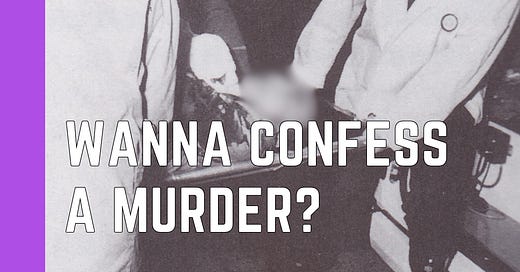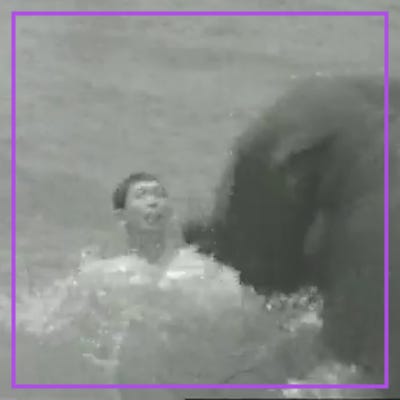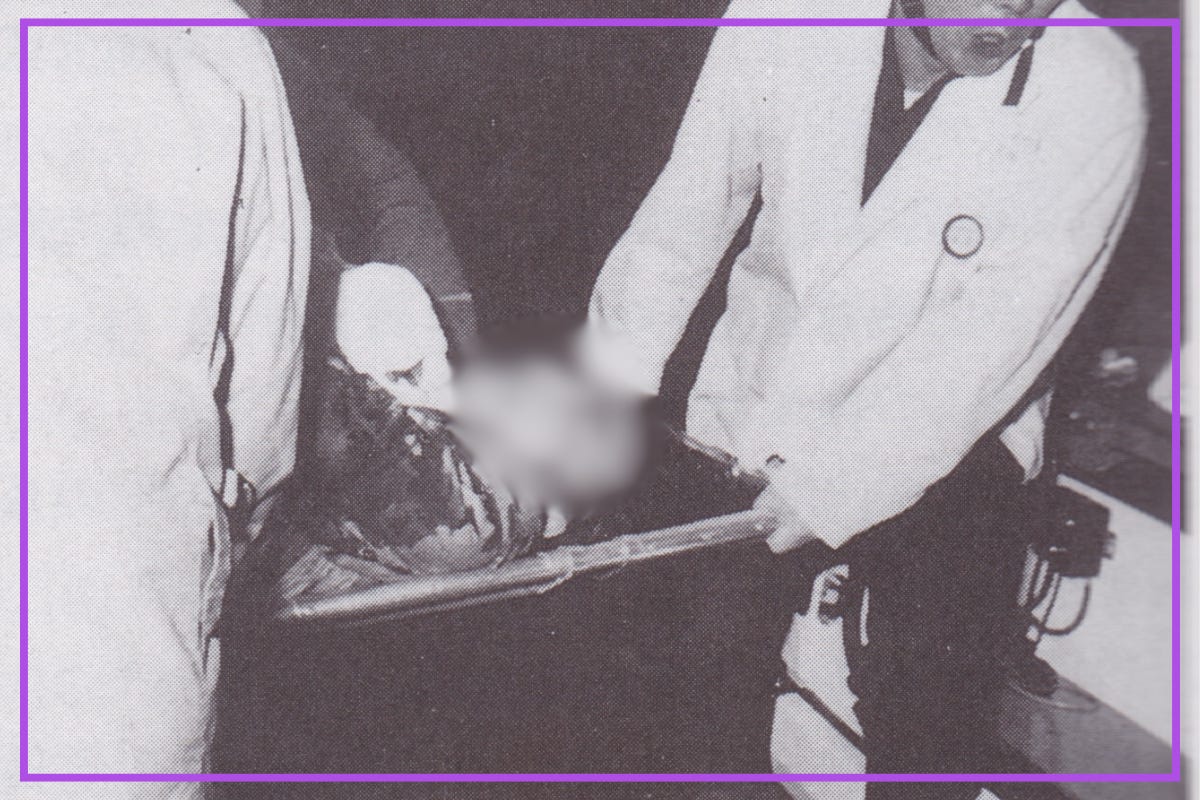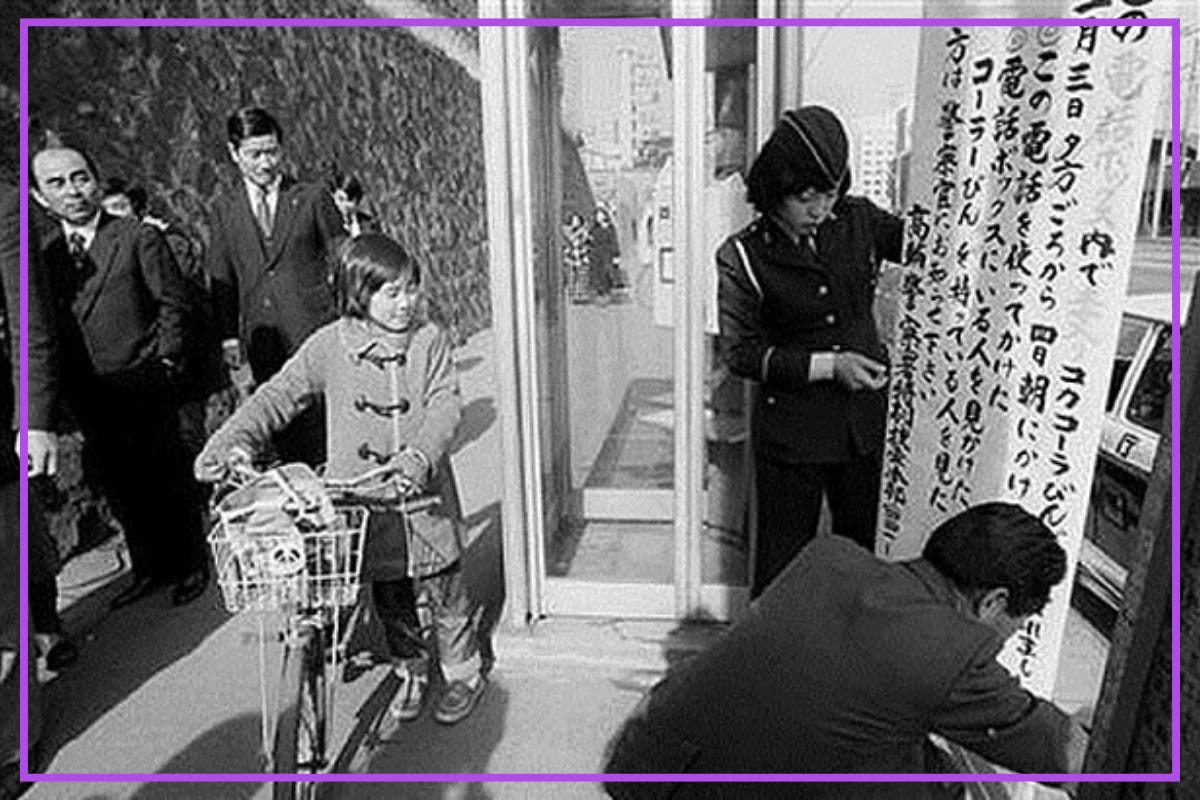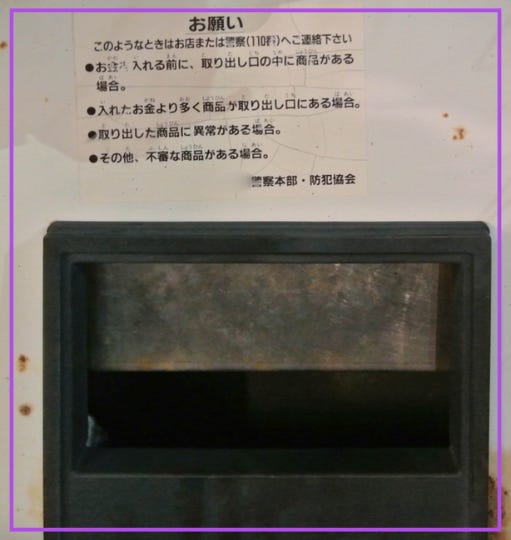Happy Elephant Day, dear readers! This commemorates today in 1792, when some enterprising Qing Dynasty sales-bros brought an elephant to Japan and managed to parlay it into a meeting with Emperor Nakamikado, who promptly took the animal for himself, thank you very much.
Image: NHK
In other elephant happenings, Kikuko — star attraction at Koshien Hanshin Park, an amusement farrago in Hyogo Prefecture — was taken for a televised frolic in the sea in 1957 amongst the holidaymakers. What could go wrong? Well, spooked by a boat, Kikuko tried to drown his keeper. You can watch that video, complete with cartoony background music playing it for laffs here. Now let’s get on with the mail:
The Quiz
Question: What’s happening here?
Answer at the foot of the mail.
The Hashtags
We’ll be honest, dear readers: sifting through the top hashtags on Japanese X/Twitter is getting harder and harder by the week, since anything that trends is immediately leaped upon by bot accounts posting the # along with AI-generated cat videos.
Now, The Kyote likes AI-generated cat videos as much as the next person, in other words not at f*cking all, so we may be reconsidering this section in the near future. Anyway, for now, on with the mayhem:
Monday April 22nd: #Vポイント
ENGLISH: “V Point”
The battle of the loyalty point cards heats up in Japan, with the T Point system (spun out from the Tsutaya video shop chain) being subsumed by Visa/Mitsui Sumitomo’s V Point system.
This leaves V Point in one-on-one competition with (this is true) the D Point system, from conglomerate Docomo.
However, this is just a gateway to reminiscence about when The Kyote plus one of our readers were young and fresh off the Shinkansen, spending many a night traipsing to the local Tsutaya to rent VHS videos off the shelves, with the occasional sneak into the curtained-off adult section.
(The Kyote did not, however, go to the trouble of having a Japanese acquaintance pen a note to try to pick up the Tsutaya clerk though!!!)
Friday April 26th: #ゴールデンウィーク
ENGLISH: “Golden Week”
Daiei Film — studio behind Kurosawa’s Rashomon (1950), Mizoguchi's Ugetsu (1953) and Sansho the Bailiff (1954), and of course that other act of transcendental cinematic genius, the 25-movies-in-11-years blind swordsman series Zatoichi (1962-1973) — had the bright idea in the Fifties of naming the wedge of national holidays at the end of April/beginning of May Golden Week.
GW is legendarily the time where everyone in Japan gazelles simultaneously onto public transport (but is actually nowhere near the mayhem of Chinese Chinese New Year [sic]). This year it seems like everyone is getting a full 10 day break, bridging public holidays plus weekends:
Sat Apr 27 Weekend
Sun Apr 28 Weekend
Mon Apr 29 Showa Day (commemorating the Showa Emperor (Hirohito))
Lucky people get Tues-Thurs off as well
Fri May 3 Constitution Memorial Day
Sat May 4 Green Day (not the band; commemorating nature innit)
Sun May 5 Children’s Day
Mon May 6 Switched Day Off (because Children’s Day falls on a Sunday)
The Kyote, however, because we’re crap, is working that Tuesday-Thursday span in the middle. You know the drill, life is a veil of tears, etc.
Saturday April 27th: #不揃いバウム
ENGLISH: “Imperfect Baum”
I’ll explain. Baumkuchen is a German spit-cooked cake which has become a popular dessert in Japan. Retailer Mujirushiryōhin (English: Muji) sells packaged baumkuchen in stores, but, due to the nature of the spit-cooking method, the exact shape of the sliced pieces can’t be standardized.
Muji sells some of these slices as specifically-labelled “imperfect baum”.
Great, right? Less food waste! Save the Earth! Three cheers for Muji!
Dear readers: you are intelligent people. Therefore you will have already understood that this is a follow-up to last week’s controversy: whether women going on maternity leave who gift colleagues cookies are committing an unacceptable act of gloating, knowing a temporary replacement will probably not be hired and thus those colleagues will have to pick up the slack until they return.
Well — guess what happened? Yep, yeah, no — actually guess — yes: a woman leaving to have a baby presented her co-workers with — shock, horror — IMPERFECT BAUM!!!
Muji’s “imperfect baum” AKA pure filth (left), Muji’s “[perfect] baum” AKA wonderful treat (right). Image: Muji
Luckily for The Kyote’s faith in humanity, the dogshits claiming the gift of imperfect baum was an act of unholy rudeness were overwhelmed by good old sensible folks lusting over the different flavors, or demanding unwanted leftovers be immediately helicoptered to their location.
The History
This week in Japanese history the following events occurred:
Wanna Confess a Murder?
Aftermath of the Asahi Newspaper Hanshin Bureau attack. Image: Mainichi Shimbun
Japan is a good place to kill someone.
It used to be the best.
Until this week in 2010, there was a 15 year statute of limitations on murder.
Read that again.
Now The Kyote believes — and let us know if we’re wrong — that even the most blissed-out hippie shithead, or thou shalt not kill religious inflexibate, when encountering the magic phrase statute of limitations on murder will immediately be assailed by a mental carousel of schoolyard bullies, lazy co-workers, bureaucratic dunderheads, noisy neighbors, current or former Presidents, plus a parent or two — or, put another way, deserving victims.
Let alone moral pygmies like The Kyote.
This legal loophole, eventually closed when some particularly gruesome killings were approaching unprosecutability (I just made that word up), means there are lagoons of unsolved cases where the actual perpetrator could, right now, walk into their local kōban, scream DETECTIIIIIIVE! YOU’RE LOOKING FOR MEEEE! and face absolutely zero legal consequences.
So, anyone fancy claiming one of these doozies below?
(Wait, hang on: the following are awful, awful murder cases where actual humans died; The Kyote is getting carried away. Let’s be sober about this, dear readers.)
* * *
The Vending Machine Poison Murders (13 dead)
Warning signs go up during the Cola case, involving long scads of text rather than the DON’T DRINK ABANDONED DRINKS it needed to be. Image: https://www.80s.ne.jp/
1985. Otsuka Pharmaceutical is suffering dwindling sales of their Oronamin C “health drink”, which the Japanese Ministry of Health and Welfare has ruled could not be actually labeled a health drink. But things were about to go from bad to worse:
On April 30, a truck driver spots one of the distinctive squat brown glass bottles of Oronamin atop a vending machine in Fukuyama, Hiroshima, and, thinking he’s lucked into a freebie, takes it home and drinks it.
Two days later he was dead.
Tests showed he had ingested paraquat, a common commercially available herbicide.
In the next 7 months, 12 more people die.
Here’s what happened:
September 11th: Izumisano City, Osaka Prefecture
A 52-year-old man buys Oronamin C from a vending machine on his way home from fishing. He notices the same product already in the dispensing slot and takes both bottles home to drink. He dies September 14th. Paraquat is detected in leftover Oronamin C.
September 12th: Matsusaka City, Mie Prefecture
A 22-year-old college student noticed two drinks in the dispensing slot after making his selection. He takes both bottles home, drinks both and dies on the 14th. The poison detected was diquat.
September 19th: Imadate, Fukui Prefecture (currently Echizen City)
30-year-old man drank a can of coke he found under a vending machine, is rushed to the hospital, dies on September 22nd. Paraquat detected.
September 20th: Miyakonojo City, Miyazaki Prefecture
45-year-old man trying to buy a drink from a vending machine notices two bottles of Real Gold (a Coca-Cola Company energy drink) in the dispensing slot. Died September 22nd. Paraquat detected in leftover Real Gold.
September 23rd: Kudoyama Town, Wakayama Prefecture
50-year-old man found two bottles of Oronamin C in the dispensing slot and took them home. Died October 7th .
October 5th: Konosu City, Saitama Prefecture
44-year-old-man found two bottles of Oronamin C in the dispensing slot. Died October 21st . Paraquat detected in leftover Oronamin C.
October 15th: Kashihara City, Nara Prefecture
69-year-old man. Same. Dies on November 13th . Paraquat detected.
October 21st: Miyagi Prefecture
A 55-year-old man. Same.
October 28th: Kawachinagano City, Osaka Prefecture
A 50-year-old man. Same.
November 7th: Urawa City, Saitama Prefecture (currently Saitama City)
42-year-old man. Same. Dies November 16th .
November 17th: Kodama District, Saitama Prefecture
Female high school student (17 years old) finds an extra coke in the dispensing slot and takes it home. She dies a week later. Paraquat was detected.
By this time there was a notice on the vending machine, explaining the previous cases and warning people not to take “free” drinks.
November 24th: Kanazawa City, Ishikawa Prefecture
25-year-old man found coffee milk in the dispensing slot and took it home. He dies 47 days later. Paraquat detected.1
* * *
What you’ll notice, here, if you know Japan, is that the doped-up drinks were spread far and wide across the country, and in basically nondescript suburbs — the kind of dreary place where even if you’ve heard the news of a mad poisoner, have read the sign on the vending machine telling you to beware of free drinks — you take them anyway, because it’s never going to happen to you, and drink them and die.
Warning on an old vending machine. Image: https://hayamine.hatenablog.jp/entry/vivo_vender
Now were all the poisonings committed by the same person? Probably. Perhaps there were a copycat or two mixed in there; certainly one of the deaths was caused by a different herbicide. There were also two other, non-fatal attacks with lime sulfur as well as 4 cases of narcissists spiking their own drinks for sympathy.
All in all fairly wild, you’d have to admit. As were the previous attacks that probably inspired them.
Yes, there was a first spree of indiscriminate poisonings, 8 years beforehand. Theat would be the Cyanide Cola and Chocolate Case from 1977: cyanide-laced Coca Cola bottles are left in public phonebooths in Tokyo, killing two, as well as boxes of chocolates in an underground shopping mall and train station bathroom, both handed in to authorities before they could do harm.
Let’s just say in late 70s-early 80s Japan, random poisonings were obviously the zeitgeist — and maybe someone had the idea of taking the big city Tokyo murder scheme and taking it on a provincial tour.
The original Coca-Cola deaths inspired a movement to redesign drink caps to make signs of tampering clear; unfortunately typical corporate leg-dragging meant the reforms came too late to save the paraquat victims.
The statue of limitations for the paraquat case expired in 2005.
The statue of limitations for the coca/chocolate case expired in 1992.
* * *
You’re Looking For Meeee! (the Ikusaka Dam Murder Case)
Ikusaka Dam, 2007. Image: Qurren, via Wikipedia
March 29th 1980. Water is released from Ikusaka Dam, Nagano Prefecture, revealing the bound body of a 21 year old man lying on the lake bed.
The man had left a female companion on the night of March 1st, got into a mysterious black car, then was not seen again until his drowned body was discovered.
Notwithstanding the vinyl ropes immobilizing his body, the Matsumoto Police Station and Nagano Prefectural Police Headquarters immediately concluded it was a case of suicide.
The cords could have been tied by the victim, including a noose! Two people had witnessed the man getting into the dark car without a struggle!
There was other stuff going on, man! People were busy.
The family of the victim never gave up hope.
* * *
Twenty years later, in the year 2000, whoever was opening the mail at Azumino Police Station read the following scrawled letter: I killed someone. Let’s talk. (人を殺したので話をする).
A drug-fiend in prison for violating the Stimulants Control Act told his story: the victim had been in the passenger side of a friend’s car when they got into an altercation at the parking lot of a sports ground. Miffed drug-fiend and a pal grabbed the victim, tied him up, then chucked him alive into the water.
Presumably, as he never came forward as a witness, the victim’s “friend” buggered off and never told a soul what had happened.
20 years after the body was discovered then, the truth was going to come out. But the police had thrown most of evidentiary materials away, so proceeded to investigate drug-fiend for a tortuous three full years before finally referring him to prosecutors, who simply pointed out the obvious: the statue of limitations had expired for the murder (15 years), but also (20 years) any civil lawsuit the victim’s family may have launched.
Was it a coincidence it took the police three years, exactly the length of time for the civil statute of limitation to also expire, to make a decision?
Could they perhaps have been making sure no testimony on their investigatory mishaps would ever be heard in open court? The Kyote is definitely not saying that.
Would it surprise you to find out that they never bothered to tell the victim’s family that the killer had confessed?
And that the victim’s mother, who had had to wage a lonely campaign to try to convince them her son had not been a suicidal contortionist, was not given that “closure” until an additional three years later.
That’s when the family found out that the killer had freely confessed to the crime — because that’s when they heard it directly from the man himself.
The state the family was reduced to by the police is summed up in the pathetic title of the book they wrote, which you can buy, right now, on Amazon, titled Thank You for Telling Us, Killer. (犯人よ、話してくれてありがとう)
* * *
When pondering the often bizarre, inflexible decisions of authority figures, The Kyote’s go-to are Charles Mackay’s Extraordinary Popular Delusions and the Madness of Crowds and On the Psychology of Military Incompetence by Norman Dixon — but there’s another book out, about the madness that emerges when law enforcement fails to face scrutiny: Beyond the Usual Beating, about maniac Chicago cop Jon Burge. Via Wikipedia:
Jon Graham Burge (December 20, 1947 – September 19, 2018) was an American police detective and commander in the Chicago Police Department. He was found guilty of having "directly participated in or implicitly approved the torture" of at least 118 people in police custody in order to force false confessions.
Following the shooting of several Chicago law enforcement officers in 1982, the police obtained confessions that contributed to convictions of two people. One filed a civil suit in 1989 against Burge, other officers, and the city, for police torture and cover-up; Burge was acquitted in 1989 because of a hung jury. He was suspended from the Chicago Police Department in 1991 and fired in 1993.
In 2002, a four-year review revealed numerous indictable crimes and other improprieties, but no indictments were made against Burge or his officers, as the statute of limitations for the crimes had expired. In 2003, Governor George Ryan pardoned four of Burge's victims who were on death row and whose convictions were based on coerced confessions.
(my emphasis)
The Answer
Question: What’s happening here?
Answer: a murder victim is drawing their killer’s face, in blood, before they expire
In the West, the victim’s dying breath indicts their murderer. In Japan, let’s hope you know what you’re doing with a dip of congealing gore — if The Kyote is ever in this position, they’ll be searching for some convulsing stick figure with features smeared across their dial.
Until next week,
The Kyote
New? Sign Up Here
Feedback? Just Hit Reply
The Kyote is published in Kyoto, Japan every Sunday at 19:00 JST

